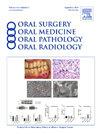Quantifying condylar distortion in panoramic radiography
IF 2
3区 医学
Q2 DENTISTRY, ORAL SURGERY & MEDICINE
Oral Surgery Oral Medicine Oral Pathology Oral Radiology
Pub Date : 2025-02-04
DOI:10.1016/j.oooo.2024.11.051
引用次数: 0
Abstract
Objective
To quantify the amount of distortion of the mandibular condyle in panoramic radiographs when comparing standard and temporomandibular joint (TMJ) programs and different patient positions.
Study Design
Five dry cadaveric mandibles were scanned using standard panoramic and TMJ modes. Markers were placed on the medial (M), lateral (L), anterior (A), posterior (P), and superior (S) aspects of the condyles. The mandibles were imaged with the AT ProVecta 3D Prime in an ideal position, right and left turn as well as chin-up and chin-down. A cone beam computed tomography scan of each mandible was taken to establish true relationships between the markers. Reproducibility was tested by reacquiring the images of one mandible and re-measuring the markers of another.
Results
Distortion was present in all images, regardless of the program and the position of the mandible. Distortion was greatest between the medial and lateral poles in the vertical dimension. Most differences between panoramic and TMJ modes were not statistically significant. Reproducibility of the method was high.
Conclusion
The AT ProVecta 3D Prime produces distortion of the condyle that impacts the radiographic appearance in panoramic radiographs. The TMJ program did not meaningfully mitigate the distortion seen with the standard panoramic program.
求助全文
约1分钟内获得全文
求助全文
来源期刊

Oral Surgery Oral Medicine Oral Pathology Oral Radiology
DENTISTRY, ORAL SURGERY & MEDICINE-
CiteScore
3.80
自引率
6.90%
发文量
1217
审稿时长
2-4 weeks
期刊介绍:
Oral Surgery, Oral Medicine, Oral Pathology and Oral Radiology is required reading for anyone in the fields of oral surgery, oral medicine, oral pathology, oral radiology or advanced general practice dentistry. It is the only major dental journal that provides a practical and complete overview of the medical and surgical techniques of dental practice in four areas. Topics covered include such current issues as dental implants, treatment of HIV-infected patients, and evaluation and treatment of TMJ disorders. The official publication for nine societies, the Journal is recommended for initial purchase in the Brandon Hill study, Selected List of Books and Journals for the Small Medical Library.
 求助内容:
求助内容: 应助结果提醒方式:
应助结果提醒方式:


